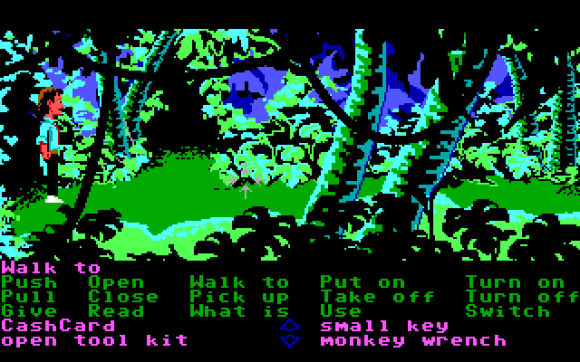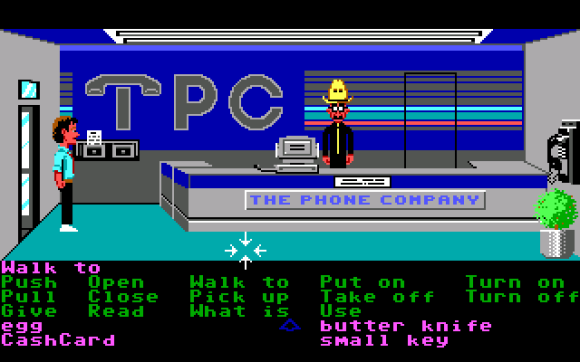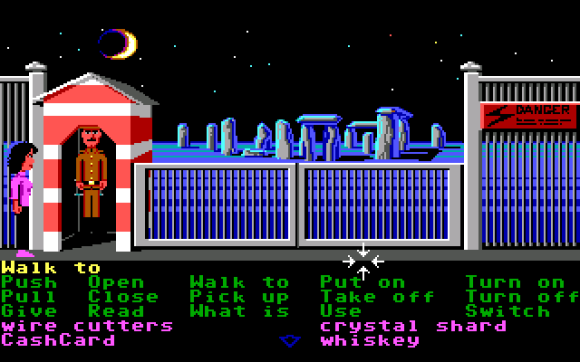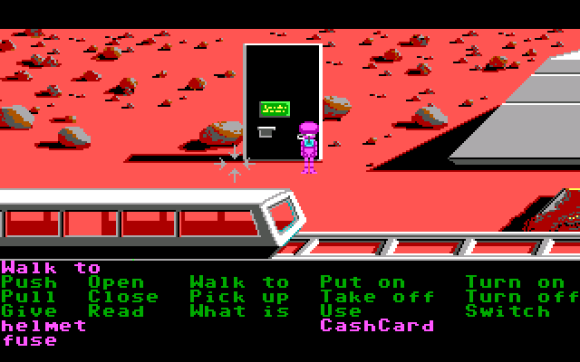Zak McKracken And The Alien Mindbenders. For something with such a mouthful of a title, and especially for something produced by LucasArts, it is surprising that I had never even heard of Zak McKracken until it was added to GOG in 2015. Nobody talks about it — or at least if they do, they don’t talk about it anywhere near as loudly as the later classics like Monkey Island and Day Of The Tentacle. Even Maniac Mansion sometimes gets a mention just for being the first modern adventure game (not to mention the entire thing being included as an easter egg in DOTT) but Zak McKracken? Might as well have been lost to history until GOG rereleased it.
This seemed strange considering how well-loved all of the other LucasArts games are, but after having played through it now I completely understand why nobody ever talks about it. It’s because Zak McKracken sucks so badly it deserves to be thrown into the memory hole and never spoken of again.
Zak McKracken is a game that has somehow aged more poorly than Maniac Mansion despite being released the year afterwards, and which doesn’t have the excuse of implementing a revolutionary new control system or trying to give you multiple combinations of playable characters. Partly this is down to its choice of subject matter: it lampoons all of the Fortean, New Age theories and phenomena that were popular during the 70s and 80s — things like ancient astronauts, sinister conspiracies, the face on Mars, magic crystals, Elvis being an alien — but which were subsequently explored in excruciating detail by later media such as The X-Files. It’s not Zak McKracken’s fault that it has been reduced to a cliche, and so I’m going to try not to hold the now-extremely obvious plot against the game. What is Zak McKracken’s fault, and what I can very much blame it for, is literally everything else that it does. All of the really annoying stuff that Maniac Mansion was guilty of and which I passed off as being the result of a brave first stab at something new, Zak McKracken doubles down on to the extent that it would almost be an amusing parody of Bad Adventure Game Practice if I wasn’t having to sit through it myself.
Zak McKracken is the poorly-told story of the eponymous Zak McKracken, a tabloid reporter for the National Inquisitor (read: Enquirer) who is very used to writing about the weird and wonderful 80s equivalent of clickbait: two-headed squirrels, flying saucers, images of Jesus Christ appearing in toast etc. etc. Not all of it is fake news, though, as it turns out there’s an alien race called the Caponians who have taken over the world’s largest phone company and are slowly making the Earth’s population dumber through the use of a “Mind-Bending Machine”. So Zak must team up with a group of women he meets in a shared dream — Annie, Leslie and Melissa — to find and construct a device left by a second alien race that counteracts the first. The catch is that the device components are scattered across various locations on the Earth and Mars, and so Zak and his friends have to do a lot of actual, literal globetrotting in order to find them.
The game starts promisingly, at least. The interface, look and feel of the thing is unchanged from Maniac Mansion — FIX is gone, but PUT ON and TAKE OFF are added so that Zak and co. can don various pieces of clothing — but the puzzles, at least initially, seem to be a little more logical. You use a butter knife to fish your credit card out from under a desk (a thing that I have actually done in real life, although not with a credit card). You find the remote control for the television under the sofa cushions. You can decant your pet fish into the sink so that you can take his fish bowl with you. Even apparent failure lets you progress, as an attempt to lever up loose floorboards with the butter knife bends it into a new and interesting shape that can then be passed off at the local pawn shop as an avant-garde sculpture. All of these were things that I solved on my own, quickly, which gave me false hope that Zak McKracken might actually be governed by normal human logic instead of the usual adventure game stuff.
Unfortunately Zak McKracken quickly leaves the realms of human logic behind and throws itself bodily into the realms of absolute incomprehensibility. Zak starts in San Francisco, which is an area consisting of a grand total of six screens: Zak’s bedroom, Zak’s apartment, 13th Avenue, the Phone Company shop, 14th Avenue and the pawn shop. To move outside of San Francisco Zak must go to the airport and get on a plane, which is when I realised just what a mess this game is: Zak can fly to any one of around fifteen locations, with no hints given as to which one he should visit first. There’s still no TALK verb here, and READ only works if the thing you want to examine has writing on it, so you have next to no direction in your quest. All you can really do is start randomly flying to places to see what’s there, but here we run into another problem: it costs money to buy airport tickets, and if Zak runs out of money he gets stranded and it’s game over. You can’t just fly around at leisure to figure this stuff out. Each location is often only two or three screens’ worth of stuff structured in such a way as to be an incredible non-sequitur — Stonehenge is right outside of the London airport, and the Pyramids are directly next to Cairo airport — and it’s very, very difficult to figure out how the locations fit together and in what order they should be visited. Not only that, but Zak McKracken is yet another adherent to the use-everything-on-everything school of puzzle design, with some truly ridiculous solutions; how am I supposed to know that offering a self-help book to a guard in Kathmandu will make him let me inside the building he’s guarding? I can’t even TALK to him to find out that he really wants a self-help book; the only way that I could possibly know that is by attempting to GIVE him everything in my inventory until I find the thing he wants.
Consequently I resorted to a walkthrough for Zak McKracken far earlier than I did for Maniac Mansion; I’m playing these games for research purposes and I just want a good feeling for how difficult they would have been to play at the time, and my feeling for Zak McKracken is that it would be impossible without copious note-taking, trial and error and a shitload of save-scumming, two out of three of which are hallmarks of terrible puzzle design. (Note-taking is fine in moderation, and to be fair to Zak McKracken I only had to make three pages’ worth of notes while I was playing it.) Even with a walkthrough it was still a terrible slog, though, as Zak McKracken has a horrifying attachment to mazes where you progress through a series of almost-identical screens each with 5-6 exits, and you have to find the right sequence of exits to get to your goal. Some of these mazes are 10-12 screens long, and even when you have the directions in front of you it’s still a good 2-3 minutes of tedious clicking to get to the end — and then you have to get back out again. It then proceeds to make things even worse by expanding on Maniac Mansion’s lighting gimmick: I didn’t mention this at the time, but Maniac Mansion has a few rooms where the light is off to begin with and you have to cast around in the dark with WHAT IS to find the light switch. Zak McKracken thinks this is an incredibly neat idea, and so applies it to entire mazes in Peru and on Mars. Every time I entered a new screen of the maze in Peru I had to toggle on WHAT IS, find the wall-mounted torch, select the lighter from my inventory and light the torch, just so that I could see where the doorways were to the next screen where I got to do it all over again. They couldn’t have made it more obnoxious if they tried, and there are at least four of these mazes in the game.
With so many locations, four different characters who have to be in different places at the same time to solve puzzles, and truly nonsensical puzzle mechanics fuelled by the New Age mythology the game thinks it’s making fun of — there’s two occasions where you have to use a magical blue crystal to possess an animal so that the animal can retrieve an item for you — Zak McKracken is one of the worst adventure games I’ve ever played1. It is unbearably ugly, with little progress having been made in the EGA artstyle since Maniac Mansion and the same primitive use of colour, fixed side-on perspective and distorted, childish proportions on everything; these strike me as being enforced by the limitations of the Commodore 64 rather than deliberate stylistic choices, but it’s still a startlingly unpleasant game to look at. There’s a little more sound this time around — LucasArts have figured out it’s a good idea to have footstep sounds in the game so that there’s at least some audible feedback to what the player is doing — but it’s still mostly restricted to painful-sounding bleeps and boops, with no music outside of the truly awful main theme that you only hear at the start and end of the game. There is some moderately interesting stuff going on with alternate routes and sequencing and multiple possible uses of certain items, but just as with Maniac Mansion all this really achieves is to create dead ends where you’ve accidentally flushed the breadcrumbs down the sink at the start of the game, and you needed those to feed a bird that you’d then possess to pick up a scroll from inside the left eye of a stone statue three hours later.
Otherwise the only real difference between Zak McKracken and Maniac Mansion is that Zak McKracken is an unfocused sprawling mess that throws everything at you at once, whereas Maniac Mansion at least kept its eye on the ball by restricting the action to a single location that the player could build up a mental map of over time as they unlocked new areas. It didn’t do it very well, but it did it far better than Zak McKracken, a game whose only redeeming feature is the box art. As box art goes, it’s merely okay (which is understandable considering how little it has to work with since it has to resort to “and these are all things that are in the game, I guess?”), but the important thing isn’t the art itself but the person LucasArts got to draw it: Steve Purcell had been laid off from LucasArts previously after the project he was working on got cancelled, but he was rehired to do the box art for Zak McKracken and worked on many subsequent LucasArts adventure games. Zak McKracken might look like something you scrape off the bottom of your shoe, but afterwards the LucasArts visuals start to improve dramatically starting with Indiana Jones And The Last Crusade, and that’s thanks in no small part to the involvement of Steve Purcell. So you could say that Zak McKracken, despite being an evolutionary dead-end itself, did indirectly benefit later LucasArts titles. Just so long as you’re willing to squint a bit.
- I should caveat this by saying that I haven’t actually played all that many non-LucasArts ones – the first two Broken Swords, Shadow Of The Comet, The Last Express, Myst, Riven, The Longest Journey, and much of Wadjet Eye’s output. Notably I have never played any of the Sierra Quest games. Maybe I’ll do that next. ↩





I have a soft spot for the sierra games, probably because I played them before the lucasarts one (except for I think Loom and The Dig, which are both great aside from the turtle puzzle…) but even so I think the Quest for Glory series is required playing at this point. I don’t know how well they hold up in 2020, particularly the stat-based or combat systems, but the thing that blew me away at the time was how you could have scenes play out in completely different ways based on the character type you chose. One character type might go to a location and pick up an item and never go back, another could experience a whole mini-narrative there.
Hmmm, that’s actually quite interesting! Another way of getting around the replayability issue — LucasArts make several attempts at this and none of them really work. I read a Let’s Play of the Quest for Glory series years ago (this was back when the majority of them were screenshot-based because YouTube didn’t exist and most people were still on 56k connections, which should tell you something about how long ago this was) and have forgotten almost all of it, but I do remember thinking that it seemed significantly more interesting than my mental image of a Sierra adventure game — which is bad art and even worse jokes. Right now I’m all adventured out, but maybe I’ll do (some) of the Sierra games next year.
I echo your thoughts on the shortcomings of this game. I managed to make it about halfway through without hints, but at some point, the puzzles became completely insufferable. Towards the endgame, I feel that it becomes borderline impossible without following a guide. The fact that you can run out of oxygen and die on Mars if you aren’t following a fairly optimal path is just the icing on the cake.
One thing worth mentioning: the original hard copy of the game came with a printout of The National Inquisitor which is 100% required to solve several of the puzzles in the game. Most of the scans I found of it are completely unreadable, but I did find a high-quality scan here: https://openretro.org/file/6359141ccb61f63f2f57d3571b516b283a553171/Paper%20%28en%29.pdf
There’s no way I would have figured out how to solve the dolphin puzzle without it!
Regarding graphics and sound quality – I didn’t figure out until half-way through my playthrough that my copy also came with the FM Towns version. If you purchased a digital copy, you most likely have it too. You can access it by hitting F5, then “Return to Launcher” and select “FM Towns”. This version has superior graphics and sound, additional music and background effects. It even includes some easter eggs you won’t find in the original, such as a poster of Maniac Mansion on the wall of the Mindbender machine, and the kazoo song is the Indiana Jones theme instead of “Pop Goes the Weasel”. Sometimes the backgrounds can be a bit muddy in this version, making it harder to pick out objects, but I’d recommend it just because you can see a whopping 10 items in your inventory at a time, rather than 4!